1/72 Heller Alpha Jet Kit No_257
I have been away from scale modeling since 1990's - I can't remember the last kit I actually built. Getting close to retirement, I figured I better make sure I still have the patience to get back into it.
This wasn't my first kit getting back to it but still I guess I could have chosen an easier build. the camouflage scheme would require some masking but nothing too complicated.
THE KIT:
This is an oldie from my stash - Heller Kit No 257 has the typical basic cockpit area made up of plain seats and instrument panel pieces without detail and with separate joysticks. There are four separate clusters of dark green plastic with 59 pieces and a transparent cluster with a canopy and a couple of wing mounted leading-edge landing lights (62 pieces total). The kit has raised panel lines with recessed lines for the control surfaces. The only external stores options are to mount the under-body pod and two bare inner wing pylons and two fuel tanks mounted on the outer wing pylons.
With the wing mounted landing lights and tail fin antenna fairings, the model depicts an early production/prototype model. Decals allow the choice of a fighter bomber prototype destined for Luftwaffe JaboG 49 which flew at Furstenfeldbruck or a colourful French Air Force Prototype with call No F-ZWRX. I found an actual picture of the German version of this kit in one of my Salamander Publications ‘An Illustrated Guide to Modern Fighters and attack Aircraft' published in 1980!
There are aftermarket suppliers which provide detailed interior and inlet components and replacement canopies if one is willing to spend the extra cash and wishes to dress up the kit – I did not choose to go that route.
CONSTRUCTION:
I started assembly with the landing gear housing and initial landing gear pieces then gluing it to the into the bottom fuselage section. The fuselage was assembled with the cockpit tub in place but leaving out the ejection seats instrument panels and joysticks until final assembly. Some nose weight was added to ensure a properly sitting model. The bottom fuselage section did not fit that that great, needing filler pretty much all around the joints. Choosing to build the German aircraft, the pointed nose piece also was a bit of a mismatch and required some filler (and that's when I broke off the front pitot tube for the first time). The inlets are shallow and lack any detail and required some filler, as did the under body cannon fairing and rear jet exhaust nozzles. You will need to be careful with the landing gear pieces as they need to be in place for the entire build and I kept breaking off one of them was assembly continued on.
The French instructions have a sectional diagram showing proper wing anhedral and under wing pylon alignment. Under wing flap control and pylon/tanks were left until final assembly. For some reason, one wing had a bigger gap on the upper surface than the other, needing more filler. Care is required to remove the raised panel line detail at the wing roots joint.
If you choose to try to build a later production model, the leading edge landing lights will need to be glued in pace and fill them and sand them smooth to cover them up. I decided to keep with the prototype build and left the lights for the final stages. Another noticeable item is the fin mounted antenna fairings which are not seen on later production models. I wanted to keep these also but left them for final assembly as the were to be painted white and gluing them in before painting the camo scheme would only make things difficult. I also left the stabilizer pieces until final assembly.
Looking at the assembled plane and all the filling and raised panel lines, I have to admit that I was a little apprehensive about how the final product would look but decided to trudge on with the kit knowing the real fun was about to begin with painting.
PAINTING:
Since the model was going to be masked with no blended paint lines, I decided to use my ol' Paasche H-1 external mix airbrush as I am not yet that comfortable with my new internal mix dual-action NEO airbrush just yet (I know, I know – gotta jump off the deep end on the next build).
Looking at the instructions, the under surfaces were to be painted with a 50/50 mix of Aluminum 7008 and Pearl Grey 7020 – looking at all the joint lines, I decided to play it safe and chose a little gray colour and hope to hide some of my poor joint lines. I choose Vallejo Model Air 71.276 USAF Light Grey with no thinning and was happy with the look and shade. Division lines shown in the instructions matched up with the photo I following the instruction sheet for division lines. The next shade was Admiral Grey 7001 – I had a few choices in deciphering the paint codes and decided that Tamiya XF-53 Neutral Grey was a proper match. Additional masking was required before the next shade Olive 7030 – again, a few ways to go but deciding on Tamiya XF-58 Olive Green would be a proper match. The Tamiya Acrylics were thinned down using X-20A thinner in a smaller container for each colour. Tamiya Masking Tape was used once again, I really like this taping product as it does provide a nice sharp paint line with minimal bleed noticed and no paint pulling off during removal. With the unit painted, the cockpit tub was then painted using Tamiya XF-66 Light Grey.
As the camouflage was basically completed all previous apprehension was gone as the painted unit really made the whole thing come together and the questionable assembly joints were no longer an issue. The complete plane was sprayed with Future/Pledge Floor Gloss in prep for the decals. I used a few black strip decals for a nice crisp line on the anti-glare panel. Deciding to add black edging at the inlets, again black trim decals were used for a crisp sharp line, brushing on Tamiya X-18 Semi-Gloss Black to complete the black surfaces. The kit decals were very stiff and had some yellowing but were still very usable, using the Micro Set/Sol system gave me great adhesion and the decals softened up pretty good. The German flag had to be trimmed with an Exacto since the colour keying was noticeably off just a touch. Photos showed a red patch at the rear base of the tail and this was added using a red trip decal. Looking at the final item, I am slightly off target on the wing insignia, but I didn't really notice until the decals were set – no biggie. The rear ‘danger' triangles were to be added after the canopy placement. The rear red engine warning lines were added from my spare decal pile.
FINAL ASSEMBLY
The port side landing gear broke off during painting, so it was repaired and the final rocker arms and tires were glued in place and were painted with Tamiya XF-16 Aluminum and gear hatch covers were then added as was the painted rear stabilizers and arrestor hook. The under wing flap controls and pylons/tanks were glued in place after a little paint was scrapped off to ensure I was gluing plastic to plastic and checking the alignment diagram once again. Care is required as there are no alignment holes for the tanks and pylon, just a light footprint of where they need to go.
I figured not much was going to be seemed in the cockpit with the canopy in place so I used some spare inaccurate instrument decals were used just so there was something to break up the gray colour. Seats, panels and joysticks were paint and glued in place.
The cockpit was masked separately and brushed to match the camo scheme. The canopy fit well enough but I did not notice until it was placed that there was going to be a thin seam line just below the actual scribed canopy lines. If I noticed sooner, I would have glued the canopy in place and masked it for spraying making sure the seam line was minimized before painting, but again – no biggie.
Rear antennae fairing were added, again care is required as there are no alignment holes and proper equalized placement is essential as the pieces are up high in the open and so close together and are painted a nice bright white.
FINALLY – a replacement pitot tube was added on the front as the one from the kit must have broken off about 10 times and somehow disappeared, the newly placed tube was painted as in the photo using Testors 2719 Italian Red and Tamiya XF-11 Silver.
Keeping the rear ‘danger' triangles for last was a mistake as they are nowhere to be found and since the front ones were set in place any substitution would be noticeable. I am sure they will turn up sometime and when they do they will be added.
As a final sign of defiance – I added the tail squadron badge from MFG2 Marineflieger and the tail stenciling from a recent F-104G kit just to see if anyone notices.
CONCLUSIONS
This was a nice build for me. I've always favoured the sharp Luftwaffe camouflage scheme and it is easy enough using a good quality tape. The Alpha Jet has some very sharp lines making it look like a pint size contender with some noticeable punch. I wanted an updated kit for a future build and hastily went out and bought the Revell 03995 Alpha Jet E kit with ‘Alpha 1000000H' markings which commemorate the French logging one million flying hours – only to find that the Revell kit uses the exact same moldings as this older Heller kit – but not problem, because I enjoy this finish product very much and will gladly build it again.
The poor fits on the fuselage, wings and pylons might make this a tough build for new beginners but it is a slight challenge worth taking as it is a nice looking final product
Completed May 28, 2020
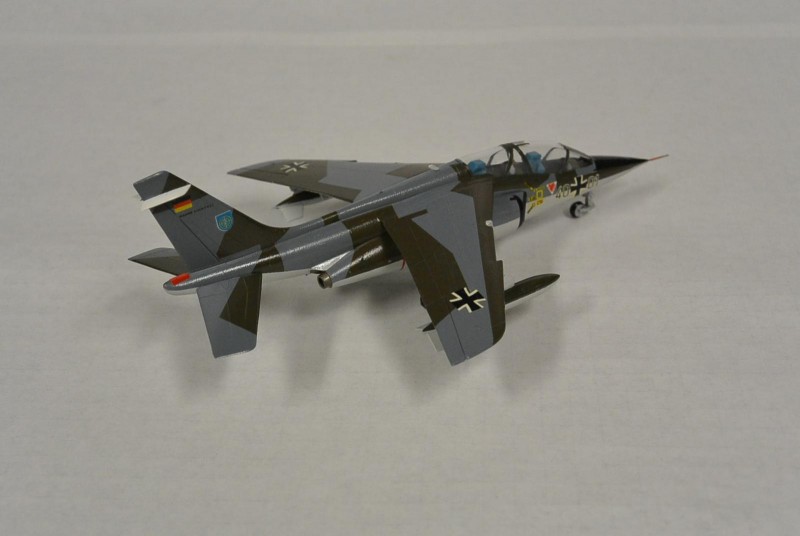
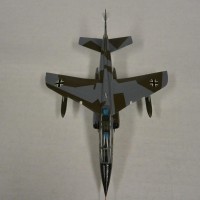
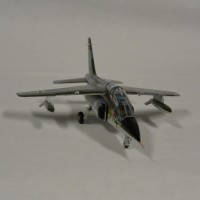
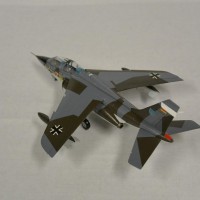
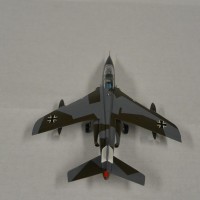

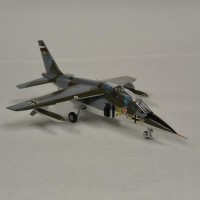
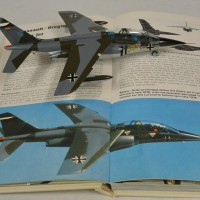
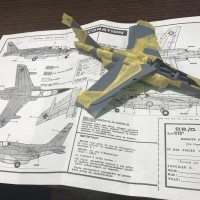
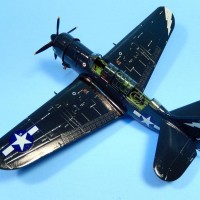
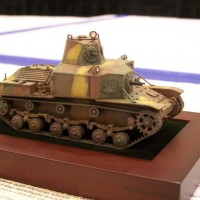

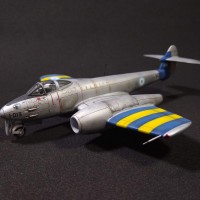
Very nice build after so many years George.
Welcome back to the modelling society.
I think you have found the correct hobby to enjoy your retirement.
Thanks John, glad I found the website.
It's slowly coming back to me as this was about the 6th model I have completed in the last 6 months or so. Trying to learn the do's and don'ts.
That's a great model and a great comeback, George!
Also liked very much your detailed and nicely written review, a pleasure to read.
Being pragmatic, in my models I bravely cut those pitot tubes from the start, as I know I will definitely break them afterwards...
For the same reason, I install landing gears at early stages ONLY when it is absolutely impossible (minor surgery included) to fit them at the end.
Congratulations for the nice build, welcome back to the hobby and welcome aboard!
Thank Spiros.
Yeah, this is one of those kits where you had no choice but to partially assemble the landing gear because the kit has all the major door flaps molded closed.
Thanks for the feedback.
I wasn't too sure if this write up should go under 'Reviews' or under 'Aviation' - hope i was correct.
Hi George @georgeswork.
Both "Reviews" and "Aviation" are correct.
I believe "Reviews" is more appropriate, as your article is very detailed, deeply examining and explaining the essential aspects of this kit's build.
Nice Job George. I built the same kit about 20 years ago with the Patrouille de France scheme. I enjoy the old Heller kits. I still have around 6 of them in my stash and about 8 completed ones.
Thanks Don - I can't remember how many Heller kits I build also a few decades ago. The F-84, F-86, Storch, Magister to name a few.
Some recent purchases of SMER and Mister Craft and Revell AG are also Heller molds, they will never go away.
There is a lot that I like about this: you started with an old, basic kit; it is 1/72; it is the Alpha Jet (and I agree - looks like it carries a sting! I've build one, but will probably build more...); you gave it some tender-lovin-care; and it turned out great! Well done.
Thanks Greg.
The Alpha Jet A model always reminded of an actual mosquito bug for some reason.
The focus was to do the build and spray with acrylics without getting too hung up on the details.
It didn't take too long to remember why I started building models in the first place.
Thanks Again.
Nicely done, and welcome aboard!
Thanks Robert, glad I found the website.
Cheers.
Looks good George, welcome to iModeler, I have a couple of these to do myself !
Thanks Allan,
glad to join the site – great support from other members!
I think everyone should do assemble an Alpha Jet.
When I showed the model to a friend of mine he mentioned he has a friend who actually flies the jet with TOP ACES, an outfit in Canada which provides Joint Tactical Air Control Training utilizing the Alpha Jet.
Maybe that is how I’ll finish the Revell kit someday.